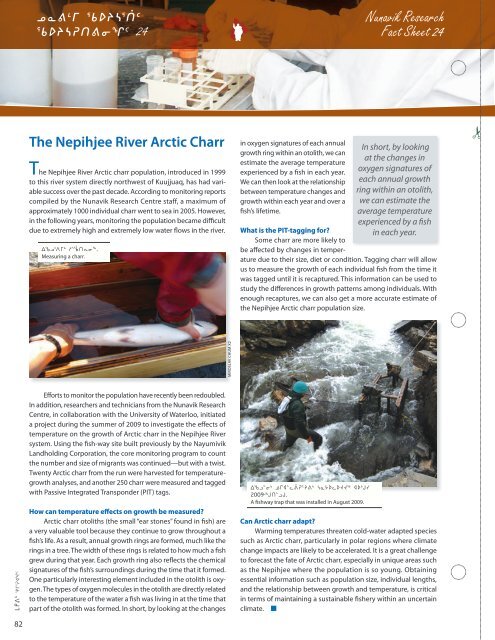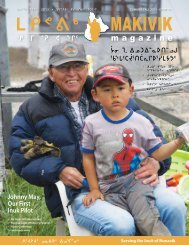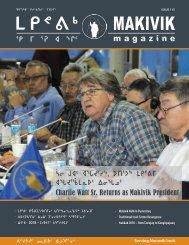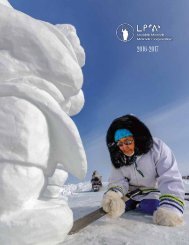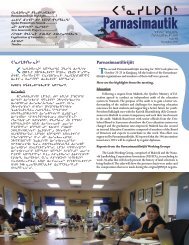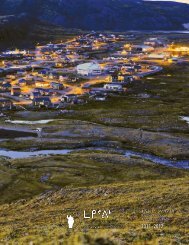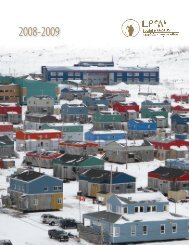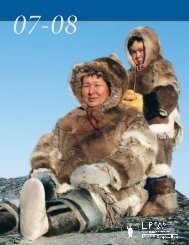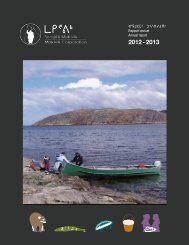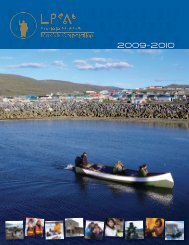You also want an ePaper? Increase the reach of your titles
YUMPU automatically turns print PDFs into web optimized ePapers that Google loves.
kN[7u 3vspn3†5<br />
3vspnDt[iq5 24<br />
Nunavik Research<br />
Fact Sheet 24<br />
The Nepihjee River Arctic Charr<br />
The Nepihjee River Arctic charr population, introduced in 1999<br />
to this river system directly northwest of Kuujjuaq, has had variable<br />
success over the past decade. According to monitoring reports<br />
compiled by the Nunavik Research Centre staff, a maximum of<br />
approximately 1000 individual charr went to sea in 2005. However,<br />
in the following years, monitoring the population became difficult<br />
due to extremely high and extremely low water flows in the river.<br />
wcl2Wu4 h3çtEi6.<br />
Measuring a charr.<br />
in oxygen signatures of each annual<br />
growth ring within an otolith, we can<br />
estimate the average temperature<br />
experienced by a fish in each year.<br />
We can then look at the relationship<br />
between temperature changes and<br />
growth within each year and over a<br />
fish’s lifetime.<br />
In short, by looking<br />
at the changes in<br />
oxygen signatures of<br />
each annual growth<br />
ring within an otolith,<br />
we can estimate the<br />
average temperature<br />
experienced by a fish<br />
in each year.<br />
What is the PIT-tagging for?<br />
Some charr are more likely to<br />
be affected by changes in temperature<br />
due to their size, diet or condition. Tagging charr will allow<br />
us to measure the growth of each individual fish from the time it<br />
was tagged until it is recaptured. This information can be used to<br />
study the differences in growth patterns among individuals. With<br />
enough recaptures, we can also get a more accurate estimate of<br />
the Nepihjee Arctic charr population size.<br />
miroslav chum x2<br />
mr[4 eu3Dxq5<br />
82<br />
Efforts to monitor the population have recently been redoubled.<br />
In addition, researchers and technicians from the Nunavik Research<br />
Centre, in collaboration with the University of Waterloo, initiated<br />
a project during the summer of 2009 to investigate the effects of<br />
temperature on the growth of Arctic charr in the Nepihjee River<br />
system. Using the fish-way site built previously by the Nayumivik<br />
Landholding Corporation, the core monitoring program to count<br />
the number and size of migrants was continued—but with a twist.<br />
Twenty Arctic charr from the run were harvested for temperaturegrowth<br />
analyses, and another 250 charr were measured and tagged<br />
with Passive Integrated Transponder (PIT) tags.<br />
How can temperature effects on growth be measured?<br />
Arctic charr otoliths (the small “ear stones” found in fish) are<br />
a very valuable tool because they continue to grow throughout a<br />
fish’s life. As a result, annual growth rings are formed, much like the<br />
rings in a tree. The width of these rings is related to how much a fish<br />
grew during that year. Each growth ring also reflects the chemical<br />
signatures of the fish’s surroundings during the time that it formed.<br />
One particularly interesting element included in the otolith is oxygen.<br />
The types of oxygen molecules in the otolith are directly related<br />
to the temperature of the water a fish was living in at the time that<br />
part of the otolith was formed. In short, by looking at the changes<br />
wcl8i4 ªQx9M“D5p[4 nNIsMsJJ6 xs4Ay<br />
@))(-at9lA.<br />
A fishway trap that was installed in August 2009.<br />
Can Arctic charr adapt?<br />
Warming temperatures threaten cold-water adapted species<br />
such as Arctic charr, particularly in polar regions where climate<br />
change impacts are likely to be accelerated. It is a great challenge<br />
to forecast the fate of Arctic charr, especially in unique areas such<br />
as the Nepihjee where the population is so young. Obtaining<br />
essential information such as population size, individual lengths,<br />
and the relationship between growth and temperature, is critical<br />
in terms of maintaining a sustainable fishery within an uncertain<br />
climate.


